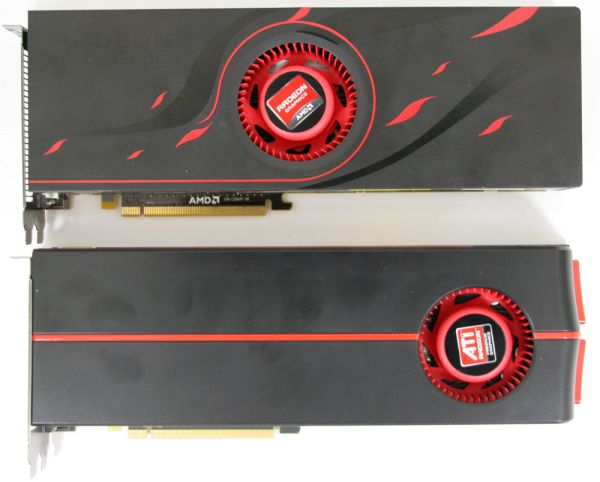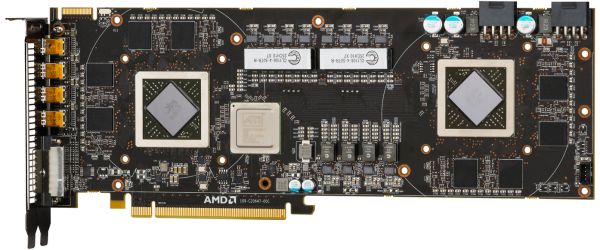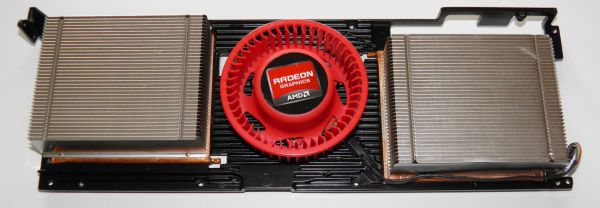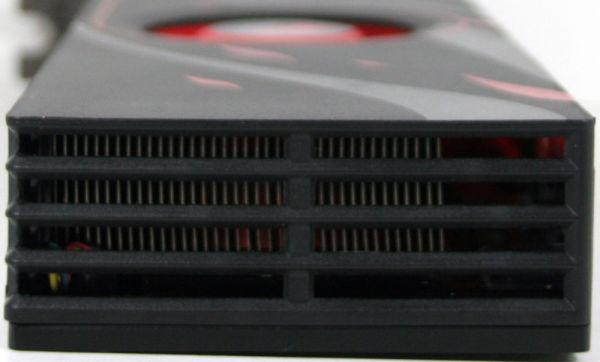AMD's Radeon HD 6990: The New Single Card King
by Ryan Smith on March 8, 2011 12:01 AM EST- Posted in
- AMD
- Radeon HD 6990
- GPUs
Meet The 6990
If you recall our coverage on the 5970, we found a few areas where AMD was lacking. The cooling on the 5970 was sufficient to run the GPUs even at 5870 clocks and voltages, however the cooling on the VRMs was lacking, leading to real world programs trigging the VRM thermal protection mechanism; and while this was within safety guidelines, it’s not a comfortable place to be for long term operation. This ultimately led to us writing off the 5970OC as a 100% reliable product, sticking to recommending the 5970 solely at stock speeds.
The design of the 6990 in turn reads very much like a response to our findings in true engineering fashion. Furthermore for the 6990 AMD not only had to take a look at the 5970’s weaknesses, but also how to handle an even greater power load. The result is that the 6990 is distinctly different from the 5970 before it.
Compared to the 5970, the 6990 is ever so slightly shorter, thanks in large part to the fact than the 6000 series casing is more squared off compared to the 5000 series’ tapered design. As a result it comes in at 11.5” for the PCB (the same as the 5970), and with casing a full 12” long compared to the 5970’s 12.16”. This means that the 6990 has effectively the same space requirements as the 5970, cooling notwithstanding.
Meanwhile it’s the fan however that is going to catch the most attention and this is where we’re going to dovetail in to cooling. The 5970’s traditional blower had its strengths and weaknesses, the strengths being that blowers are relatively forgiving about a case’s ability to exhaust hot air, and the weaknesses being that the GPU (and VRMs) closest to the fan received better cooling than the farther GPU. The VRMs proved to be particularly problematic, as they could overheat well before the GPUs did and AMD does not spin up their fans based on VRM temperatures.
Correcting for this and at the same time allowing for even greater heat dissipation, the rear blower design is out. Its replacement is a design that we’ve seen in 3rd party cards before such as the Asus ARES 5870X2, but not in a reference design: a center-mounted fan/blower with a GPU to each side. The difference is critical and indeed cannot be understated: a rear blower channels most hot air outside of the case, while a center-mounted blower effectively splits the card in two, with one GPU + supporting chips being exhausted outside of the case, and the 2nd GPU + supporting chips being exhausted inside the case. The design is still enclosed, so everything goes out either the front or back of the card while fresh air is pulled in the center.
With the replacement of the blower, so has gone the heatsink. The 5970’s single large vapor chamber + heatsink design has been replaced in favor of a segmented heatsink, further driving home the concept that the 6990 is closer to 2 video cards sharing 1PCB than it is 2 GPUs on one card. Each heatsink in turn is connected to the GPU via its own vapor chamber, resulting in the GPUs being fully isolated from each other as far as cooling is concerned.
Even the thermal paste connecting the GPUs to the vapor chambers has been changed for the 6990 – AMD has replaced traditional paste with a phase change material. Phase change materials – pastes/pads of material that melt and solidify based on temperature are nothing new, however they’re still exotic; material similar to what AMD is using is not readily available as paste is. AMD even went so far as to suggest that reviewers not directly disassemble their 6990s as it would require a new application of phase change paste in order to achieve the same efficiency as the original material. The net result of all of this by AMD’s numbers is that the phase change material is 8% better than the regular paste they’ve been using.
Rounding out our focus on cooling is the VRMs, which have been relocated in order to correct for the 5970’s limited VRM cooling capabilities. The VRMs and controllers are now at the center of the board – now they’re cooled before the GPUs or RAM modules are. The profoundness of this is twofold: not only is it an improvement on the 5970, but with the 6990’s higher power consumption VRM cooling is even more important. As with the 6970, voltage regulation is supplied by Volterra MOSFETs and controllers.
All told, while the 5970 was designed to handle and dissipate 400W of heat, the 6990 is officially designed for 450W. In practice, at its limits in our test rig this is closer to 500W. To handle and dissipate that much heat in roughly 72in3 of space is nothing short of amazing.


















130 Comments
View All Comments
nafhan - Tuesday, March 8, 2011 - link
I generally buy cards in the $100-$200 range. Power usage has gone up a bit while performance has increased exponentially over the last 10 years.LtGoonRush - Tuesday, March 8, 2011 - link
I'm disappointed at the choices AMD made with the cooler. The noise levels are truly intolerable, it seems like it would have made more sense to go with a triple-slot card that would be more capable of handling the heat without painful levels of noise. It'll be interesting to see how the aftermarket cooler vendors like Arctic Cooling and Thermalright handle this.Ryan Smith - Tuesday, March 8, 2011 - link
There's actually a good reason for that. I don't believe I mentioned this in the article, but AMD is STRONGLY suggesting not to put a card next to the 6990. It moves so much air that another card blocking its airflow would run the significant risk of killing it.What does this have to do with triple-slot coolers? By leaving a space open, it's already taking up 3 spaces. If the cooler itself takes up 3 spaces, those 3 spaces + 1 open space is now 4 spaces. You'd be hard pressed to find a suitable ATX board and case that could house a pair of these cards in Crossfire if you needed 8 open spaces. Triple slot coolers are effectively the kryptonite for SLI/CF, which is why NVIDIA isn't in favor of them either (but that's a story for another time).
arkcom - Tuesday, March 8, 2011 - link
2.5 slot cooler. That would guarantee at least half a slot is left for airspace.Quidam67 - Tuesday, March 8, 2011 - link
if it means a quieter card then that might have been a compromise worth making. Also, 2.5 would stop people from making the il-advised choice of using the slot next to the card, thus possibly killing it!strikeback03 - Tuesday, March 8, 2011 - link
With the height of a triple slot card maybe they could mount the fan on an angle to prevent blocking it off.kilkennycat - Tuesday, March 8, 2011 - link
Triple-slot coolers... no need!!However, if one is even contemplating Crossfire or SLI then a triple-slot space between the PCIe X16 SOCKETS for a pair of high-power 2-slot-cooler graphics cards with "open-fan" cooling (like the 6990) is recommended to avoid one card being fried by lack of air. This socket-spacing allows a one-slot clear air-space for the "rear" card's intake fan to "breathe". (Obviously, one must not plug any other card into any motherboard socket present in this slot)
In the case of a pair of 6990 (or a pair of nVidia's upcoming dual-GPU card), a minimum one-slot air-space between cards becomes MANDATORY, unless custom water or cryo cooling is installed.
Very few current Crossfire/SLI-compatible motherboards have triple-slot (or more) spaces between the two PCIe X16 connectors while simultaneously also having genuine X16 data-paths to both connectors. That socket spacing is becoming more common with high-end Sandy-Bridge motherboards, but functionality may still may be constrained by X8 PCIe data-paths at the primary pair of X16 connectors.
To even attempt to satisfy the data demands of a pair of 6990 Cross-Fire with a SINGLE physical CPU, you really do need a X58 motherboard and a Gulftown Corei7 990x processor, or maybe a Corei7 970 heavily overclocked. For X58 motherboards with triple-spaced PCIe sockets properly suitable for Crossfire or SLI , you need to look at the Asrock X58 "Extreme" series of motherboards. These do indeed allow full X16 data-paths to the two primary PCIe X16 "triple-spaced" sockets.
Many ATX motherboards have a third "so-called" PCIe X16 socket in the "slot7" position. However, this slot is always incapable of a genuine X16 pairing with either of the other two "X16" sockets, Anyway this "slot 7" location will not allow any more than a two-slot wide card when the motherboard is installed in a PC "tower" -- an open-fan graphics card will have no proper ventilation here, as it comes right up against either the power-supply (if bottom-loaded) or the bottom-plate of the case.
Spazweasel - Tuesday, March 8, 2011 - link
Exactly. For people who are going to do quad-Crossfire with these, you pretty much have to add the cost of a liquid cooling system to the price of the cards, and it's going to have to be a pretty studly liquid cooler too. Of course, the kind of person who "needs" (funny, using that word!) two of these is also probably the kind of person who would do the work to implement a liquid cooling system, so that may be less of an issue than it otherwise might be.So, here's the question (more rhetorical than anything else). For a given ultra-high-end gaming goal, say, Crysis @ max settings, 60fps @ 3x 2500x1600 monitors (something that would require quad Crossfire 69xx or 3-way SLI 580), with a targeted max temperature and noise level... which is the cheaper solution by the time you take into account cooling, case, high-end motherboard, the cards themselves? That's the cost-comparison that needs to be made, not just the cost of the cards themselves.
tzhu07 - Tuesday, March 8, 2011 - link
Before anyone thinks of buying this card stock, you should really go out and get a sense of what that kind of noise level is like. Unless you have a pair of high quality expensive noise-cancelling earbuds and you're playing games at a loud volume, you're going to constantly hear the fan.$700 isn't the real price. Add on some aftermarket cooling and that's how much you're going to spend.
Don't wake the neighbors...
Spivonious - Tuesday, March 8, 2011 - link
70dB is the maximum volume before risk of hearing loss, according to the EPA. http://www.epa.gov/history/topics/noise/01.htmSeriously, AMD, it's time to look at getting more performance per Watt.